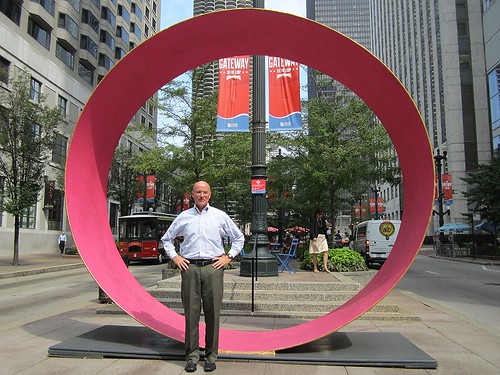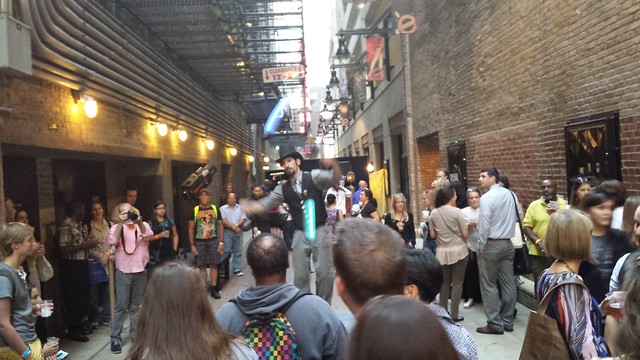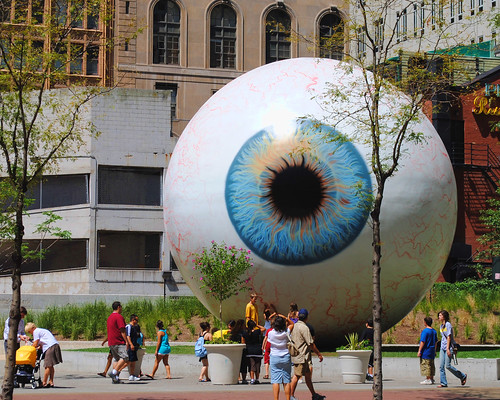Last year the Chicago Loop Alliance, one of the downtown chambers of commerce, rolled out several successful placemaking campaigns, activating underused public spaces in an effort to make the central business district a better place for people to hang out, relax and socialize. These included the Pop-Up Art Loop program, which turns empty storefronts into temporary galleries, the Gateway seating area in the median of State at Wacker, and Activate Couch Place, an arts event held in the eponymous alley.
This year the CLA is upping the ante by amplifying these programs and adding some new ones. There will be monthly alley events, more live performances at the Gateway People Plaza, downtown’s first People Spot mini-park, the activation of underused Pritzker Park, and tables and chairs temporarily installed on a rotating basis in dozens of locations throughout the Loop.
“Part of our mission is to improve people’s experience at street level, and placemaking is a big part of that,” CLA director Michael Edwards told me. “It’s part of a bigger trend. Because of mobile communications, people aren’t chained to their desks anymore. Cities with vibrant public spaces are more attractive to millennials and people who want to live downtown. They’re places that encourage creativity. So activating public spaces is an opportunity we wanted to explore.” The CLA’s entire 2014 placemaking project has a budget of $135,000, including special service area funds and corporate sponsorship.
In September, Activate Couch Place drew scores of people to the alley, located north of Randolph between State and Dearborn, for free libations, art installations, dance music, a fashion show and circus performers. This year there will be one event per month from May to October, likely two events each in Couch Place, the alley next to Iwan Ries cigar shop, 19 South Wabash, and the passageway next to the Loop Target store, 1 South State. “We plan to power wash the alleys before the events, so there’s a benefit for the businesses,” Edwards said. Each happening will feature music, lighting and drinks, with a different theme every month, such as dance, fashion, classical music, kinetic art, and performance art.
The Gateway will reopen in May, with seating for up to 50 people located in a plaza that was formerly underused. There were a few performances there last year by guitar players, a cellist and a children’s choir. This year there will be additional programming, possibly including music, art installations, dance and film screenings, Edwards said.
The downtown People Spot will be located at the northwest corner of Dearborn and Adams, next to an Argo Tea shop in the historic Marquette Building, occupying two car parking spaces, located between the Dearborn protected bike lane and mixed traffic lanes. It will consist of tables and chairs, similar to parklets that were established in Lakeview and Bronzeville. The CLA is splitting the estimated $6,000 pricetag with the Metropolitan Planning Council, which is headquartered in the building.
It’s always puzzled me why Pritzker Park, located on prime real estate at the northwest corner of State and Van Buren has existed for years as an underperforming space. A patch of undistinguished green space occupying a good chunk of a city block, it has no proper seating, save for a low wall that serves as an uncomfortable perch. The park’s moment in the spotlight was when the CLA temporarily installed a massive eyeball sculpture by Tony Tassett there in summer 2010.
Edwards doesn’t blame the Chicago Park District, which owns the space, for it’s ho-hum atmosphere. “It’s a challenge for municipalities to activate public spaces on their own,” he said. “They do a good job of removing the snow and cutting the grass, but they’ve got too much on their plate to worry about things like planting flowers, putting twinkle lights in the trees, and doing consistent programming. They would likely agree that the CLA is better suited to that kind of fine tuning.”
Edwards met with the park district yesterday to discuss the possibility of involving park neighbors like the Washington Library, Robert Morris College, Depaul University, John Marshall Law School, and the Fisher Building to help out with programming events at the space. “We’re hoping that, through the park district, we can invite a few more people to the party.” The CLA plans to use art, lighting, and new seating to create a more welcoming space, and Edwards says amenities might include include visits from food trucks and a snack stand run by the local icon Garett’s Popcorn Shop.
Perhaps most intriguing is the plan for pop-up seating that will rotate though up to 150 different underused open areas, both public and private (with the consent of the owners), in the Loop. “We want to create nice public spaces with two or three tables and a few chairs in various locations as an experiment and see what people do with them,” Edwards said. “We’re trying to demonstrate the benefits to property owners, that maybe if there was more seating, people might spend more money at their restaurants.”
The seating will be placed at various locations three times a week from 10 a.m. to 2 p.m., starting with locations on State and then branching out to Wabash and Dearborn. “There will be a degree of spontaneity involved,” Edwards said. “We’ll try to create a buzz through social media about where the next pop-up space will be, and people will be able to let us know where they’d like to see more seating via Twitter, so the working title for the program is Tweet Seats.”






